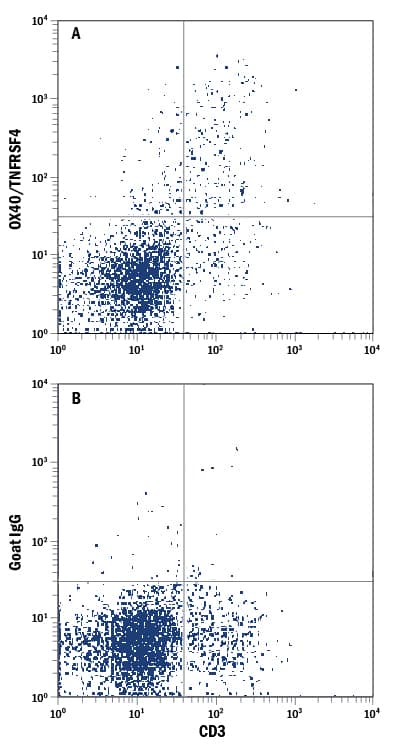Mouse OX40/TNFRSF4 PE-conjugated Antibody
R&D Systems, part of Bio-Techne | Catalog # FAB1256P


Key Product Details
Species Reactivity
Validated:
Cited:
Applications
Validated:
Cited:
Label
Antibody Source
Product Specifications
Immunogen
Val20-Pro211
Accession # P47741
Specificity
Clonality
Host
Isotype
Scientific Data Images for Mouse OX40/TNFRSF4 PE-conjugated Antibody
Detection of OX40/TNFRSF4 in Mouse Splenocytes by Flow Cytometry.
Activated-mouse splenocytes were stained with Rat Anti-Mouse CD3 APC-conjugated Monoclonal Antibody (Catalog # FAB4841A) and either (A) Goat Anti-Mouse OX40/TNFRSF4 PE-conjugated Antigen Affinity-purified Polyclonal Antibody (Catalog # FAB1256P) or (B) Normal Goat IgG Phycoerythrin Control (Catalog # IC108P). View our protocol for Staining Membrane-associated Proteins.Applications for Mouse OX40/TNFRSF4 PE-conjugated Antibody
Flow Cytometry
Sample: Activated-mouse splenocytes
Formulation, Preparation, and Storage
Purification
Formulation
Shipping
Stability & Storage
Background: OX40
OX40, also known as CD134, was originally identified as an activated rat CD4+ T cell-surface antigen that is recognized by the monoclonal antibody MRC OX40. It is a member of the tumor necrosis factor receptor superfamily (TNFRSF) and has been designated TNFRSF4. Mouse OX40 cDNA encodes a 256 amino acid (aa) residues type I transmembrane precursor protein with a putative 19 aa signal peptide, a 192 aa extracellular domain containing 4 TNFR-cysteine rich repeats, a 25 aa transmembrane domain and a 36 aa cytoplasmic region. A naturally occurring soluble OX40 has also been identified in human serum. Mouse OX40 shares approximately 63% and 90% aa sequence identity with its human and rat counterparts, respectively. OX40 is a T cell activation antigen that is expressed primarily on activated CD4+ T cells, but is also expressed on activated human and mouse CD8+ T cells. The ligand of OX40 is OX40 Ligand (OX40L), also known as gp34, a type II transmembrane glycoprotein belonging to the TNF superfamily. OX40L is expressed on activated B cells, T cells, dendritic cells and endothelial cells. Ligation of OX40 on T cells by OX40L or an agonistic antibody can promote clonal expansion, long-term T cell survival, and enhance memory T cell development. In vivo, blockade of OX40/OX40L interaction has been useful for treating autoimmune disease and graft-versus-host disease in animal models. Activation of OX40 has also been utilized to enhance the potency of vaccines and augment anti-tumor immunity (1-9).
References
- Paterson, D.J. et al. (1987) Mol. Immunol. 24:1281.
- Mallett, S. et al. (1990) EMBO J. 9:1063.
- Calderhead, D.M. et al. (1993) J. Immunol. 151:5261.
- Baum, P.R. et al. (1994) EMBO J. 13:3992.
- Gramaglia, I. et al. (1998) J. Immunol. 161:6510.
- Bansal-Pakala, P. et al. (2001) Nature Medicine 7:907.
- Rogers, P.R. et al. (2001) Immunity 15:445.
- Taylor, L. and H.J. Schwarz (2001) Immunol. Methods 255:67.
- Weinberg, A.D. (2002) Trends in Immunol. 23:102.
Alternate Names
Gene Symbol
UniProt
Additional OX40 Products
Product Documents for Mouse OX40/TNFRSF4 PE-conjugated Antibody
Product Specific Notices for Mouse OX40/TNFRSF4 PE-conjugated Antibody
For research use only